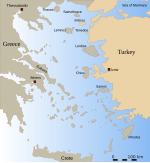Leros
In ancient times it was considered the island of Parthenos Iokallis and linked to the Hellenistic and Roman literature on Meleager and the Meleagrides.
The Leros Municipal Airport at Partheni connects the island multiple times a day with Athens (45 minute flight).
Many local songs of Leros are among the most famous in the traditional (nisiotika) music of Greece, the most celebrated being "Pos to Trivun to Piperi", "Mes tou Aegeou ta Nisia" and "Proutzos".
On the island of Farmaco east from Leros, a few miles from Didyma on the Turkish coast, Julius Caesar was held as a hostage by local pirates for forty days.
He dressed women and children in the armor of the dead defenders, convincing the Ottomans that the garrison of Leros was still strong.
Finally, on 24 December 1522, following the siege of Rhodes, a treaty was signed between Sultan Suleiman and the Grand Master of the Knights, Philippe Villiers de L'Isle-Adam, and Leros, along with all the Aegean possessions of the Order, passed into Ottoman hands which ruled the island with brief interruptions during a period of four hundred years.
With the Treaty of London, on 3 February 1830, however, which determined the borders of the newly established Greek state, the freed islands of the Eastern Sporades were given over to the Ottoman Empire again.
According to the Ottoman General Census of 1881/82-1893, the kaza of Leros had a total population of 6.754, consisting of 6.623 Greeks, 18 Muslims and 113 foreign citizens.
The fortification of Leros and the creation of a major naval base ensured that the Italians had control over an area of vital interest to the Allies (the Aegean, the Dardanelles and the Near East).
Mussolini, who called Leros "the Corregidor of the Mediterranean", saw the island as a crucial base for the Italian domination of the eastern Aegean Sea.
From 1940, when Italy entered the Second World War on the side of Germany, Leros suffered bombing raids by the British, including Port Laki, on 26 November 1940, by the Royal Navy (Fleet Air Arm) - Swordfish aircraft of 815 and 819 Squadrons, operating from HMS Illustrious.
As a result of the excellent anchorage provided to warships by the many natural coves, the island was the second most bombed during World War Two (after Crete).
[citation needed] On 8 September 1943, as Italy could not continue the war on the German side, it signed an armistice and came over to the Allied camp.
One of the largest attacks was on the Greek Navy's flagship, the Vasilissa Olga, sunk by German bombers on Sunday, 26 September 1943, along with HMS Intrepid, while they were anchored in Portolago.
The island of Leros was finally captured by German troops during Operation Taifun in airborne and amphibious assaults between 12–16 November 1943.
During the dictatorship period of Greece (1967-1974), 4,000 political prisoners were exiled in the same spaces of the mental hospital which were used as a concentration camp.
[11] The hotspot of Leros is located near the mental hospital which has been internationally known as "Europe's guilty secret", as coined in an Observer article.
[12] In the same space of Lepida (after almost 15 years of implementing deinstitutionalisation programmes financed by EU), about 200 patients are still accommodated in small rehabilitation structures.











